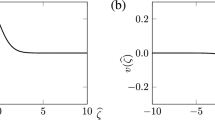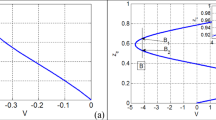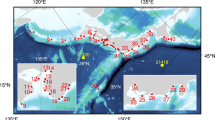Abstract
Ship wave pattern is a fascinating research topic in the fields of marine hydrodynamics and water waves. Within the pure-gravity wave theory, the ship wave pattern composed of transverse waves and divergent waves appearing on the downstream is confined within a sector symmetrical about the ship track with a half-angle 19†28′. However, when the surface tension is accounted for, the wave pattern is greatly modified especially at a low translating speed. Besides the minimum speed of capillary waves c min = 0.23 m/s below which waves cannot be generated, there is another critical speed c div = 0.45 m/s associated with the disappearance of divergent waves. In the present paper, the wave patterns created by a steadily translating source are studied, and they are examined with the crestlines obtained from the asymptotic analysis.
Similar content being viewed by others
References
Dias F. Ship waves and Kelvin [J]. Journal of Fluid Mechanics, 2014, 746: 1–4.
Lighthill J. Waves in fluids [M]. Cambridge, UK: Cambridge University Press, 1960.
Ellingsen S. A. Ship waves in the presence of uniform vorticity [J]. Journal of Fluid Mechanics, 2013, 742: R2.
Zhu Y., He J., Zhang C. et al. Farfield waves created by a monohull ship in shallow water [J]. European Journal of Mechanics-B/Fluids, 2015, 49: 226–234.
Pethiyagoda R., McCue S. W., Moroney T. J. et al. Jacobian-free Newton-Krylov methods with GPU acceleration for computing nonlinear ship wave patterns [J]. Journal of Computational Physics, 2014, 269(10): 297–313.
Faltinsen O. M. Hydrodynamics of high-speed marine vehicles [M]. Cambridge, UK: Cambridge University Press, 2005.
Doyle T. B., McKenzie J. F. Stationary wave patterns in deep water [J]. Quaestiones Mathematicae, 2013, 36(4): 487–500.
Moisy F., Rabaud M. Mach-like capillary-gravity wakes [J]. Physical Review E, 2014, 90(2): 023009.
Liang H., Chen X. Far-field behaviours of steady capillary-gravity ship waves [C]. The 32nd International Workshop on Water Waves and Floating Bodies. Dalian, China, 2017.
Lamb H. Hydrodynamics [M]. Sixth Edition. Cambridge, UK: Cambridge University Press, 1932.
Binnie A. M. Solutions of the fish-line problem at intermediate velocities [J]. British Journal of Applied Physics, 1965, 16(11): 1755–1758.
Gradshtejn I. S., Ryzhik I. M. Table of integrals, series and products [M]. New York, USA: Academic Press, 1965.
Crapper G. D. Surface waves generated by a travelling pressure point [J]. Proceedings of the Royal Society London, 1964, 282(1391): 547–558.
Chen X. B., Noblesse F. Dispersion relation and far-field waves [C]. The 12th International Workshop on Water Waves and Floating Bodies. Carry le Rouet, France, 1997.
Chen X. B. Analytical features of unsteady ship waves (Chwang A. T., Teng M. H., Valentine D. T. Advances in Engineering Mechanic–Reflections and outlook [M]. Singapore: World Scientific, 2004, 371–389.
Dias F., Dyachenko A. I., Zakharov V. E. Theory of weakly damped free-surface flows: A new formulation based on potential flow solutions [J]. Physics Letters A, 2008, 372(8): 1297–1302.
Noblesse F., Chen X. B. Decomposition of free-surface effects into wave and near-field components [J]. Ship Technology Research, 1995, 42: 167–185.
Noblesse F., He J., Zhu Y. Why can ship wakes appear narrower than Kelvin’s angle?[J]. European Journal of Mechanics-B/Fluids, 2014, 46: 164–171.
Author information
Authors and Affiliations
Corresponding author
Additional information
Biography: Hui Liang (1988-), Male, Ph. D., Research Engineer
Rights and permissions
About this article
Cite this article
Liang, H., Chen, X. Capillary-gravity ship wave patterns. J Hydrodyn 29, 825–830 (2017). https://doi.org/10.1016/S1001-6058(16)60794-1
Received:
Revised:
Published:
Issue Date:
DOI: https://doi.org/10.1016/S1001-6058(16)60794-1




